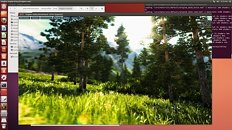Monday, February 11th 2013
Unigine Returns with Two New GPU Benchmark Apps
A little later this week, Unigine Corp. will be announcing two new GPU benchmark apps, the Valley 1.0, and Heaven 4.0. The two apps are cross-platform, in that they support both Windows and Linux (x86/x64). On Windows, the two can max out feature-sets of the latest DirectX 11.x APIs, while on Linux, the two take advantage of the latest OpenGL 4.x. Valley uses an entirely new test scene that's a beautiful springtime depiction of a valley. Distant snow-capped peaks, a treeline, and dense foliage, the scene's got it all, coupled with lighting, and depth of field effects. Definitely something we'd like our GPUs to trip on.
Moving on, Unigine's second benchmark suite for the season is Heaven 4.0, while builds on the current Heaven 3.0 benchmark. It adds SSDO (scene-space dimensional occlusion), improved lens flare, a rendered starscape at night time, GPU temperature and clock monitoring, improved multi-GPU detection, and various bug fixes. The two should be released some time around Thursday (14/02).
Source:
Phoronix
Moving on, Unigine's second benchmark suite for the season is Heaven 4.0, while builds on the current Heaven 3.0 benchmark. It adds SSDO (scene-space dimensional occlusion), improved lens flare, a rendered starscape at night time, GPU temperature and clock monitoring, improved multi-GPU detection, and various bug fixes. The two should be released some time around Thursday (14/02).


28 Comments on Unigine Returns with Two New GPU Benchmark Apps
I am not in position to disclose any details, but I was running many benchmarks of a certain game on Windows [using Direct3D and OpenGL renderers] and on Linux [using OpenGL renderer in two different modes]. I am not allowed to tell much, but I can say:
On Linux, OpenGL in both modes had much better performance than OpenGL on Windows. Mostly because the Windows GPU driver sux when it comes to OpenGL, while on Linux the GPU driver is more optimized and works way better with OpenGL workloads [which is its only mode].
Thus, defaulting to Direct3D on Windows is a sane thing to do.
/* meanwhile... */
To some of You: please, stop saying "DirectX" when it comes to graphics only. DirectX is an API that supplies a very wide range of services. Including, but not limited to: input, sound, networking, graphics, AV decoding, and so on. And the part that deals with graphics is Direct3D. Thus, when talking about the graphics portion of DirectX, please, say "Direct3D".
<sarcasm>...unless maybe Your GPU can do hardware acceleration on mouse input, for example. Which is part of DirectX, but not part of Direct3D.</sarcasm>
I'm on an i7-2600k @ 4.8 GHz, 2x 7970 @ 1200/1800, 13.2 beta 5 drivers
At 1440p resolution, maxed out with 4xAA, Heaven 3.0 gives me 89.6 fps and a score of 2256
At 1440p resolution, maxed out with 4xAA, Heaven 4.0 gives me 58.0 fps and a score of 1462
The lighting effects, especially with the dynamic weather and time of day, are nice. But the draw distances and pop-in on objects, textures, and shadows, are inexcusably bad for a benchmark.